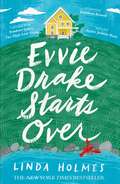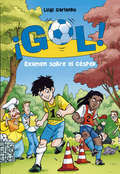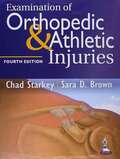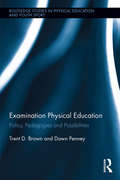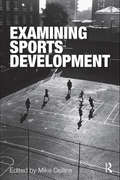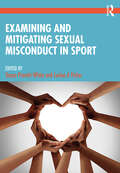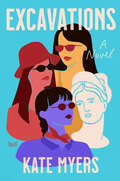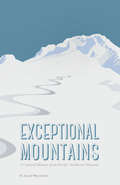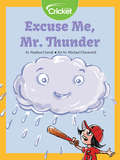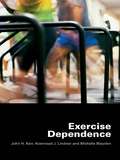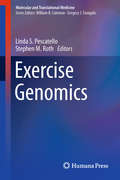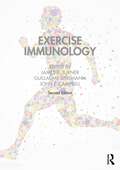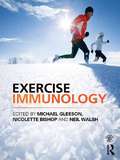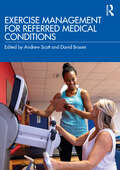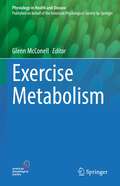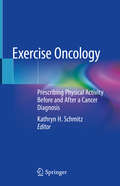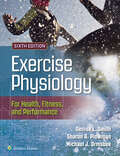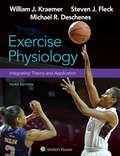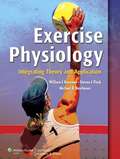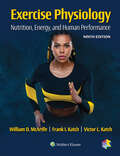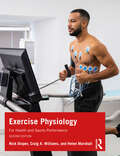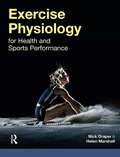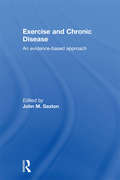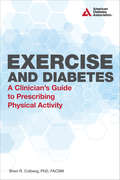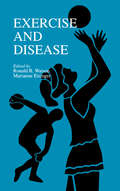- Table View
- List View
Evvie Drake Starts Over: the perfect, romantic, feel-good read for spring
by Linda Holmes'I guzzled it up' -- Pandora Sykes, THE HIGH LOW SHOW'A quirky, sweet, and splendid story of a woman coming into her own . . . an absolute delight' -- Taylor Jenkins Reid, author of DAISY JONES AND THE SIX and THE SEVEN HUSBANDS OF EVELYN HUGO'Charming, hopeful and gently romantic. Evvie Drake is great company' -- Rainbow Rowell, author of ATTACHMENTSTHE NEW YORK TIMES BESTSELLER A BOOK CLUB PICK AS FEATURED ON THE TODAY SHOW 'Everything a romantic comedy should be: witty, relatable, and a little complicated' People'Effortlessly enjoyable . . . [a] pitch-perfect . . . adult love story that is as romantic as it is real' USA TodayIt's been a year since Evvie Drake's husband died, but she still can't leave the house. Her best friend Andy thinks it's because she's grieving, and she does nothing to make him think otherwise.Dean Tenney was once a sports star. Now he's a former sports star who has lost his ability to throw a ball better than anyone else, and he can't even explain why. When Dean moves into the apartment at the back of Evvie's house, the two make a deal: Dean won't ask about Evvie's dead husband, and Evvie won't ask about Dean's failed career. But as Dean and Evvie grow closer, could it be that these rules are the one thing in the way of them starting over?
Examen sobre el césped (Serie ¡Gol! #Volumen 22)
by Luigi Garlando¡El nuevo equipo formado por los Cebolletas y los Tiburones Azules por fin saltará sobre el césped! Quince niñ@s.Una pasión: el fútbol.Un sueño: ¡ser los mejores! Pronto va a empezar el campeonato regional y los Cebolletas tienen que decidir su alineación titular. ¿Podrá Tomi mantener el número 9? ¿Será Pedro el nuevo líder? Los chicos todavía no están convencidos con la fusión de equipos, así que los místeres Champignon y Walter se enfrentarán al más duro de los retos: trabajar en equipo para dar ejemplo y no defraudar a nadie.
Examination Of Orthopedic And Athletic Injuries
by Chad Starkey Sara D. Brown"This is by far the most comprehensive and user-friendly text for both professor and student! I am continuing to use it in my Athletic Training Program, and beginning next year, I will institute it into my PT courses in Ortho I & II."—Vincent J. Hudson, MS, PT, ATC, MBA, University of Central Florida, Orlando, Florida, review of a previous edition. Completely revised and updated, the 4th Edition of the field’s standard resource brings you all field’s most current knowledge and an all-new full-color art program. Its superb combination of detailed illustrations and precise language makes even the most complicated concepts and techniques clear. Organized by body region, each chapter begins with a review of anatomy and biomechanics; proceeds through clinical evaluation, pathologies, and related special tests; and concludes with a discussion of on-field or initial management of specific injuries. The Plus Code inside new, printed texts gives you access to the instructor and student resources online at DavisPlus, including your Davis Digital Version, range of motion animations, and review questions for every chapter.
Examination Physical Education: Policy, Practice and Possibilities (Routledge Studies in Physical Education and Youth Sport)
by Dawn Penney Trent D. BrownIn recent decades physical education has moved from the margins, redefining itself as an academic subject. An important component of this transformation has been the introduction of high-stakes examinations at key points in a student’s school career and the emergence of ‘examination physical education’ as the dominant paradigm in many educational systems around the world. This book is the first to explore the growing international literature on examination physical education and draw on research to extend the political, academic and professional debates around the subject to explore its limitations and possibilities. Addressing key topics such as curriculum development, assessment methods, and teacher education, it seeks to assess how our existing knowledge of examination physical education can be best translated into pedagogical practice in the classroom. Complementing other texts in the Routledge Studies in Physical Education and Youth Sport Series, it makes an original and informed contribution to current discussions of physical education. Examination Physical Education: Policy, Practice and Possibilities is important reading for any student, researcher or teacher educator with an interest in physical education, sports pedagogy and education policy.
Examining Sports Development
by Mike CollinsSports development takes place in continually evolving – and expanding – territory. If new policies are to be implemented effectively, it is vital to understand how development policy translates into the real world. Until now no single text has examined how sports development policies are implemented and experienced ‘at the coal face’ of community and performance sport. As well as critical analysis of models and concepts in sports development, Examining Sports Development presents original case studies from practising sports development professionals working in a variety of areas, including: national and regional policy school sport talent identification and development sports club development coach development sport and social inclusion sports and crime prevention sports and health promotion. Sports development is evolving as a profession, especially in matters of education and training. This book encourages critical reflection, pointing the way to accountable policymaking and a long-term future for sports development professionals. It is essential reading for all students and practitioners working in sports development.
Examining and Mitigating Sexual Misconduct in Sport
by Tanya Prewitt-White Leslee A. FisherSexual Misconduct in any environment is a gross abuse of trust and this is no different within the sport world. Examining and Mitigating Sexual Misconduct in Sport outlines systemic and sociological explanations for why sport is a site of sexual misconduct. The authors in the text describe cultural realities and considerations sport stakeholders must acknowledge and be informed of to make sport a more equitable and safe space. Personal narratives from a variety of sport stakeholders, which unveil their lived experiences of sexual misconduct and humanize survivor stories in ways often ignored in sport and society, are shared. Authors offer recommendations to all sport stakeholders to mitigate incidents of and harm done by sexual misconduct. Guidelines and suggestions for sport stakeholder practices that better protect individuals in sport, address sexual misconduct when it occurs, and mitigate the harm and trauma experienced because of incidents of sexual misconduct are also examined and provided. This book is the first text of its kind to invite sport stakeholders to have open, vulnerable, and honest discussions around a timely topic often minimized, denied and/or ignored in sport. A ground-breaking new book, Examining and Mitigating Sexual Misconduct in Sport is key reading for any sport coach, sport parent, sport psychology professional, or sport administrator.
Excavations: A Novel
by Kate MyersUSA TODAY BESTSELLER • BEST SUMMER READS OF 2023: The New York Post • Oprah Book Club • Oprah Daily • USA Today • Good Housekeeping • Brit + Co • The Good Trade • Parade • Zibby Mag • O Quaterly“Funny, smart and deeply delicious.” —Amy Poehler “Witty and acerbic, Myers’ debut is humorous and sharply written, as if Aubrey Plaza’s April Ludgate from Parks and Recreation decided to write a sun-drenched novel about feminism, friendship, and archeology.” —BooklistOver a summer in sun-drenched Greece, four incompatible women digging into the past may just find the answers to their futures. An "academic satire with a feminist bent... Fresh, funny, intelligent, and deeply satisfying.”—Kirkus (Starred Review)On a remote archeological site in Greece, the mythic home of the first Olympics, four women discover an unusual artifact. It’s a piece of history that definitely shouldn’t exist. And for the head archaeologist in charge, a relic himself, it means something’s gone horribly wrong.Elise, Kara, Z and Patty all find themselves digging here together, but they couldn’t be farther apart. Kara’s a polished conservator calling off her wedding. Patty and her bowl cut are desperate for love. Millennial Z just got dumped and fired yet again. And Elise, their star excavator, is a lone wolf about to go rogue. To figure out what they’re really digging for, and to topple the man who wants to hide their history, these dirt-crusted colleagues have to become what they’ve avoided for years—friends. If they put their own messes aside for one summer, they might just make the discovery of a lifetime.
Exceptional Mountains: A Cultural History of the Pacific Northwest Volcanoes
by O. Alan WeltzienOver the past 150 years, people have flocked to the Pacific Northwest in increasing numbers, in part due to the region’s beauty and one of its most exceptional features: volcanoes. This segment of the Pacific Ring of Fire has shaped not only the physical landscape of the region but also the psychological landscape, and with it the narratives we compose about ourselves. Exceptional Mountains is a cultural history of the Northwest volcanoes and the environmental impact of outdoor recreation in this region. It probes the relationship between these volcanoes and regional identity, particularly in the era of mass mountaineering and population growth in the Northwest. O. Alan Weltzien demonstrates how mountaineering is but one conspicuous example of the outdoor recreation industry’s unrestricted and problematic growth. He explores the implications of our assumptions that there are no limits to our outdoor recreation habits and that access to the highest mountains should include amenities for affluent consumers. Each chapter probes the mountain-based regional ethos and the concomitant sense of privilege and entitlement from different vantages to illuminate the consumerist mind-set as a reductive—and deeply problematic—version of experience and identity in and around some of the nation’s most striking mountains.
Excuse Me, Mr. Thunder
by Stephen CravakAlly needs to rest up for the big game tomorrow, but she is awakened first by the wind, then the rain, and finally thunder. She politely asks them to leave, which they do, until game time.
Exercise Dependence
by John H. Kerr Michelle Blaydon Koenraad J. LindnerExercise dependence or addiction has been described as a 'positive addiction', but it can have links with damaging dysfunctional and excessive behaviours, including eating disorders. Clinical and sport psychologists now acknowledge the condition and report that it can be found in recreational exercisers and competitive athletes. This is the first text to provide a comprehensive guide to exercise dependence. The text contains case studies and reviews research into exercise dependence in both 'exercise' and 'sports' contexts. The authors examine the condition in the widest sense, exploring different types of exercise dependence, risk factors associated with the condition, the experiences and motivational characteristics of sufferers, links with eating disorders, and a number of approaches to counselling. This text will be of significant interest to psychologists working in sport, health and clinical practice, as well as to athletes and sports coaches, particularly those involved in endurance sports associated with higher incidences of exercise dependence.
Exercise Genomics
by Linda S. Pescatello Stephen M. RothExercise Genomics encompasses the translation of exercise genomics into preventive medicine by presenting a broad overview of the rapidly expanding research examining the role of genetics and genomics within the areas of exercise performance and health-related physical activity. Leading researchers from a number of the key exercise genomics research groups around the world have been brought together to provide updates and analysis on the key discoveries of the past decade, as well as lend insights and opinion about the future of exercise genomics, especially within the contexts of translational and personalized medicine. Clinicians, researchers and health/fitness professionals will gain up-to-date background on the key findings and critical unanswered questions across several areas of exercise genomics, including performance, body composition, metabolism, and cardiovascular disease risk factors. Importantly, basic information on genomics, research methods, and statistics are presented within the context of exercise science to provide students and professionals with the foundation from which to fully engage with the more detailed chapters covering specific traits. Exercise Genomics will be of great value to health/fitness professionals and graduate students in kinesiology, public health and sports medicine desiring to learn more about the translation of exercise genomics into preventive medicine.
Exercise Immunology
by James E. Turner John P. Campbell Guillaume SpielmannExercise immunology is a discipline at the nexus of exercise physiology and immunology that aims to characterise the effects of exercise on the immune system in health and disease. This new edition of Exercise Immunology begins by providing an evidence‑based introduction to the effects that individual bouts of exercise and exercise training have on the characteristics and functioning of the immune system.In addition to introducing the immune system and summarising how different forms of exercise affect the characteristics and functioning of the immune system, this new and fully revised edition will explore exercise immunology in the context of immune ageing, cancer, autoimmune diseases and cardiometabolic disease. In addition, the authors discuss other factors that impact immune health, such as nutrition and environmental stressors, and explain the physiological basis of how exercise changes immune function across the healthspan and lifespan.This book is written by leading exercise immunologists and is structured to provide a suggested curriculum of an exercise immunology degree component. Every chapter includes summaries of current and up‑to‑date research and offers practical guidelines to translate laboratory‑based information into clinical settings. This textbook is essential for any exercise immunology degree component or advanced exercise physiology degree and will be vital reading for students in exercise and biological sciences and clinicians and researchers interested in the therapeutic applications of exercise.
Exercise Immunology
by Michael Gleeson Nicolette Bishop Neil WalshExercise immunology is an important, emerging sub-discipline within exercise physiology, concerned with the relationship between exercise, immune function and infection risk. This book offers a comprehensive, up-to-date and evidence-based introduction to exercise immunology, including the physiological and molecular mechanisms that determine immune function and the implications for health and performance in sport and everyday life. Written by a team of leading exercise physiologists, the book describes the characteristics of the immune system and how its components are organised to form an immune response. It explains the physiological basis of the relationship between stress, physical activity, immune function and infection risk, and identifies the ways in which exercise and nutrition interact with immune function in athletes and non-athletes. The book shows students how to evaluate the strengths and limitations of the evidence linking physical activity, immune system integrity and health, and explains why exercise is associated with anti-inflammatory effects that are potentially beneficial to long-term health. Every chapter includes useful features, such as clear summaries, definitions of key terms, discussions of seminal research studies and practical guidelines for athletes on ways to minimise infection risk, with additional learning resources available on a companion website. This is an essential textbook for any course on exercise immunology or advanced exercise physiology.
Exercise Management for Referred Medical Conditions
by Andrew Scott David BroomExercise referral describes the process of consultation, planning and instructing physical activity programmes and applying appropriate behaviour change strategies for clients presenting a range of low- to medium-risk medical conditions. Exercise Management for Referred Medical Conditions is the first book to integrate exercise prescription with the development of healthy behaviours and the promotion of physical activity and well-being and provides students with an evidence-based, applied guide to becoming effective exercise referral practitioners. The book draws upon the latest research and recommends best practices for creating referral pathways, providing exercise programmes and engaging clients in health lifestyles. Covering the pathology, medical management, role of exercise and recommendations for programming in each case, it discusses a range of conditions, including: Obesity and type I and II diabetes Hypertension and dyslipidaemia Asthma Low back pain, osteoarthritis and joint replacement, rheumatoid arthritis, and osteoporosis Depression, anxiety and stress disorders Consistently organised and laden with pedagogical features, including learning objectives, key terms, case studies, future developments and chapter summaries, no other book offers such a clear, holistic model for exercise referral. This is a vital resource for any student undertaking vocational courses in exercise referral and an important reference for exercise scientists, physical therapists, fitness professionals or local policy-makers interested in the use of physical activity in healthcare.
Exercise Metabolism (Physiology in Health and Disease)
by Glenn McConellIn this Edited Volume, a diverse group of exercise metabolism experts, assembled a multi-facetted collection of fascinating contributions. The chapters focus on metabolism during exercise, including anaerobic and aerobic metabolism, carbohydrate metabolism (separate chapters on muscle glycogen and blood glucose), fat metabolism (separate chapters on muscle and adipose tissue) and protein metabolism. Readers will find discussion on various tissues in addition to skeletal muscle, such as liver, heart and brain metabolism during exercise. In addition, the book includes chapters on other perspectives such as thermodynamic and bioenergetic aspects of exercise and a dive into history. Another focal point is on the effects of exercise in relation to training, age, sex, fatigue and the circadian rhythm. This contemporary collection will be an essential resource for Physiologists, Sports Scientists, Coaches, Athletes and students alike.
Exercise Oncology: Prescribing Physical Activity Before and After a Cancer Diagnosis
by Kathryn H. SchmitzThis groundbreaking book presents a unique and practical approach to the evolving field of exercise oncology - the study of physical activity in the context of cancer prevention and control. Presenting the current state of the art, the book is sensibly divided into four thematic sections. Following an opening chapter presenting an overview and timeline of exercise oncology, the chapters comprising part I discuss primary cancer prevention, physical activity and survivorship, and the mechanisms by which these operate. Diagnosis and treatment considerations are discussed in part II, including prehabilitation, exercise during surgical recovery, infusion and radiation therapies, and treatment efficacy. Post-treatment and end-of-life care are covered in part III, including cardio-oncology, energetics and palliative care. Part IV presents behavioral, logistical and policy-making considerations, highlighting a multidisciplinary approach to exercise oncology as well as practical matters such as reimbursement and economics.Written and edited by experts in the field, Exercise Oncology will be a go-to practical resource for sports medicine clinicians, family and primary care physicians, oncologists, physical therapy and rehabilitation specialists, and all medical professionals who treat cancer patients.
Exercise Physiology for Health, Fitness, and Performance (Lippincott Connect)
by Denise Smith Sharon Plowman Michael OrmsbeeWith this new 6th Edition, Exercise Physiology for Health, Fitness, and Performance continues to provide an authoritative resource for mastering exercise physiology. This engaging, accessible and approachable resource integrates theoretical and research-based basic exercise physiology with real-world application to prepare students for exciting positions in exercise science, fitness, physical education, athletic training, rehabilitation, coaching, and/or allied health professions. Updated throughout, the text uses sound pedagogical principles to explain scientific research that is the foundation of exercise physiology and incorporates multiple features to help students apply their knowledge to improve human health, fitness, and performance. Content in this edition is organized by independent units (Metabolic, Cardiovascular-Respiratory, Neuromuscular-Skeletal, and Neuroendocrine-Immune), offering maximum teaching flexibility for faculty and ensuring a consistent, efficient, and effective learning experience for students.
Exercise Physiology: Integrating Theory And Application
by William Kraemer Steven Fleck Michael DeschenesBuild the foundation of scientific knowledge and practical decision-making skills needed to excel in an exercise training career Master the core concepts of exercise physiology and learn how to apply them to the real-world challenges of exercise training with Exercise Physiology: Integrating Theory and Application, Third Edition. Designed to connect theory to practice, this engaging, accessible text gives students a thorough understanding of how the body adapts to exercise and environmental stresses and how basic physiology informs practical decisions. This new edition expands the coverage of practical applications, extends on our growing scientific knowledge of exercise physiology, explores the topic of “Exercise is Medicine”, and offers more guidance on finding reliable research-based answers to real-life questions. New content, as well as updated coverage of the endocrine system, applying research, nutritional support, and environmental effects make this the perfect resource to support the diverse case scenarios seen by personal trainers, strength coaches, fitness instructors, athletic trainers, and other exercise professionals.
Exercise Physiology: Integrating Theory and Application
by William J. Kraemer Steven J. Fleck Michael R. DeschenesDesigned for undergraduate course work, this exercise physiology textbook unites research and theory with real-world application so students can easily relate to the concepts being presented. The unique applied approach fully engages you in discovering how the human body works and responds to exercise. You’ll not only gain a solid foundation in exercise physiology concepts, you’ll also learn how to apply these concepts on the job to optimize athletic performance and well-being. Moreover, you’ll come to understand the vital health benefits of exercise and physical activity for all individuals at all ages, including special populations. <p><p> Beginning with basic exercise physiology concepts, the text progressively builds your knowledge by integrating these concepts into practical discussions of nutrition and training. The text stresses a research-based approach, enabling you to locate and evaluate the evidence you need to make good decisions. Numerous examples further underscore the importance of basic concepts and research in addressing real-life challenges in exercise and athletic training.
Exercise Physiology: Nutrition, Energy, and Human Performance
by Frank I. Katch Victor L. Katch William McArdleSelected as a Doody's Core Title for 2022! <P><P> Lippincott® Connect Featured Title Purchase of the new print edition of this Lippincott® Connect title includes access to the digital version of the book, plus related materials such as videos and multiple-choice Q&A and self-assessments. <P><P> Join the nearly half a million students who have built a solid foundation in the scientific principles underlying modern exercise physiology with this trusted, trendsetting text. Exercise Physiology: Nutrition, Energy, and Human Performance, 9th Edition, presents a research-centric approach in a vibrant, engaging design to make complex topics accessible and deliver a comprehensive understanding of how nutrition, energy transfer, and exercise training affect human performance. The extensively updated 9th Edition reflects the latest advances in the field as well as a rich contextual perspective to ensure readiness for today’s clinical challenges.
Exercise Physiology: for Health and Sports Performance
by Craig Williams Nick Draper Helen MarshallThis second edition of Exercise Physiology: For Health and Sports Performance brings together all the essential human anatomy and applied physiology that students of exercise science, physical education, and sports coaching will need to know.Written in a friendly, accessible style, and containing a wide range of features to help develop understanding, this book provides a complete one-stop shop for exercise physiology broken down into three fundamental parts: foundations of exercise physiology, applied exercise physiology, and the new Part 3, exercise prescription.With Parts 1 and 2 examining the theory, testing, and practical applications of exercise physiology, the new Part 3 reflects the changes in the field by increasing focus on physical activity and diverse populations and helps provides a more complete course text for any exercise physiology course at universities around the world.This newly revised book is key reading for undergraduate and postgraduate students in the fields of exercise physiology, sports performance, sports therapy, fitness and personal training, and other related sport science courses.
Exercise Physiology: for Health and Sports Performance
by Nick Draper Helen MarshallExercise Physiology for Health and Sports Performance brings together all the essential human anatomy and applied physiology that students of exercise science, physical education and sports coaching need to know. Written in a friendly, accessible style and containing a wide range of features to help develop understanding, this book provides a complete one-stop-shop for exercise physiology. The book is split into two key parts. Part One introduces the fundamental principles of nutrition, biochemistry, cell biology and the energy systems. Part Two builds on this foundation by applying the theory to exercise and sports performance in practice. With this innovative approach, the text enables you to become confident in your knowledge and understanding of energy generation and training principles for all sports. Including coverage of exercise in extreme environments and applications of physical activity for health, this will be the only exercise physiology textbook you will need!
Exercise and Chronic Disease: An Evidence-Based Approach
by John M. SaxtonIt is now widely accepted that there are important links between inactivity and lifestyle-related chronic diseases, and that exercise can bring tangible therapeutic benefits to people with long-term chronic conditions. Exercise and Chronic Disease: An Evidence-Based Approach offers the most up-to-date survey currently available of the scientific and clinical evidence underlying the effects of exercise in relation to functional outcomes, disease-specific health-related outcomes and quality of life in patients with chronic disease conditions. Drawing on data from randomized controlled trials and observational evidence, and written by a team of leading international researchers and medical and health practitioners, the book explores the evidence across a wide range of chronic diseases, including: cancer heart disease stroke diabetes parkinson's disease multiple sclerosis asthma. Each chapter addresses the frequency, intensity, duration and modality of exercise that might be employed as an intervention for each condition and, importantly, assesses the impact of exercise interventions in relation to outcomes that reflect tangible benefits to patients. No other book on this subject places the patient and the evidence directly at the heart of the study, and therefore this book will be essential reading for all exercise scientists, health scientists and medical professionals looking to develop their knowledge and professional practice.
Exercise and Diabetes
by Sheri R. ColbergPhysical movement has a positive effect on physical fitness, morbidity, and mortality in individuals with diabetes. Although exercise has long been considered a cornerstone of diabetes management, many health care providers fail to prescribe it. In addition, many fitness professionals may be unaware of the complexities of including physical activity in the management of diabetes. Giving patients or clients a full exercise prescription that take other chronic conditions commonly accompanying diabetes into account may be too time-consuming for or beyond the expertise of many health care and fitness professionals.The purpose of this book is to cover the recommended types and quantities of physical activities that can and should be undertaken by all individuals with any type of diabetes, along with precautions related to medication use and diabetes-related health complications. Medications used to control diabetes should augment lifestyle improvements like increased daily physical activity rather than replace them.Up until now, professional books with exercise information and prescriptions were not timely or interactive enough to easily provide busy professionals with access to the latest recommendations for each unique patient. However, simply instructing patients to "exercise more" is frequently not motivating or informative enough to get them regularly or safely active. This book is changing all that with its up-to-date and easy-to-prescribe exercise and physical activity recommendations and relevant case studies.Read and learn to quickly prescribe effective and appropriate exercise to everyone.
Exercise and Disease
by Marianne EisingerExercise and Disease reviews the role of exercise and physical fitness in the prevention or causation of cancer. Relevant mechanistic studies, particularly immunomodulation, are emphasized. The book also interprets effects of long-term exercise on immune functions and data that shows how exercise influences disease resistance. On the other hand, exercise may be involved in immune mediated motion injuries. Finally, exercise plays a potential role in cancer therapy. The book will be useful to researchers interested in the most recent developments and their interpretations.
